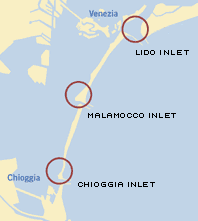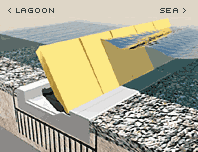|
This is the Venetian lagoon with the city at its center. These are
the three lagoon inlets. They are the openings, which connect the
lagoon to the sea. This is where the mobile defenses will be
installed—a system of gates designed to solve the problem of
high water, which is becoming increasingly frequent and intense.
Imagine that the system is already in place and let us draw nearer
onboard a helicopter. We're at the Malamocco inlet, framed by two
long jetties. The tide is at a normal level and the gates, which
come into operation only when tides higher than 100 cm
[40 inches] are forecast, are
completely invisible in the bed of the canal. The only structures
visible merge with the surrounding landscape and are of modest
dimensions, like this building.
Now on a small bathyscaphe, which gives us an idea of the dimensions
of the gates, we reach the bed. The seat of the line of gates is set
into a trench on the bed of the inlet. The gates have one side
attached to their base by means of two hinges. Special paint is
applied to their exterior, which protects them from the aggression
of the marine environment.
Now, let's go and see how they're made inside. Inside we see the
modular metallic structure, which assures maximum resistance of the
gates to the pounding of the wave motion. But how do they function
exactly?
When exceptionally high water is forecast, compressed air is pumped
into the gates to empty the water that keeps them on the seabed. As
the water is expelled, the gates, rotating around the axis of the
hinges, rise until they emerge and isolate the lagoon from the sea.
When the high water ebbs and the water in the lagoon and the sea
reach the same level the gates are filled once again with water
until they return to their original position.
The mobile defenses, on average, come into position about seven
times a year and remain functioning only during high water. The
system protects the Venetian lagoon, its inhabitants, its
extraordinary city, and its invaluable historical, artistic, and
environmental patrimony from all high waters as well as from the
risks of extreme events.
Opening the gates, which we see here, is carried out according to
precise procedures, with which the possible increase in the water
level of the lagoon, resulting from the flow of the rivers, from
rain, from local increases due to the wind, and water passing
between one gate and another, is also taken into account.
The gates are 20 meters [66 feet] wide, 5 meters [16.5 feet] thick,
and a maximum length of 30 meters [99 feet] where the bed is
deepest. The time needed to open the entire line of gates is 30
minutes, and 15 minutes to close it. At the end of the raising phase
the upper part of the gates emerges until it forms a continuous
line, which closes the inlet, preventing the tide from entering and
maintaining the water in the lagoon at a safe level.
The system is designed to sustain a difference in level between the
sea and the lagoon of up to two meters [6.5 feet]. It will therefore
also be effective in the case of relevant increase in sea level
during the next century. Fishing boats, emergency vessels, or
leisure boats can enter the lagoon through a refuge haven with a
lock created at the side of the inlet canal. The functions and the
control plant are also installed here.
The mobile defenses, chosen after comparison with many other defense
systems, do not reduce the exchange of water caused by the tides and
are compatible with the ongoing and future environmental equilibrium
interventions of the lagoon and with the development of the port.
Building the system will take eight years at a cost of 3,700 billion
lire [$1.9 billion] and will directly employ about 1,200 workers a
year. This development of new activities and new qualified work also
implies the safeguarding of Venice.


|

|
The gates would be installed at the three lagoon inlets,
the gaps in the coastal strip through which the tides
flow into the lagoon.
|
|

|
When in operation, the gates form a continuous barrier
that blocks the flow of the tide, keeping the water
level in the lagoon at a safe height.
|
|
|

